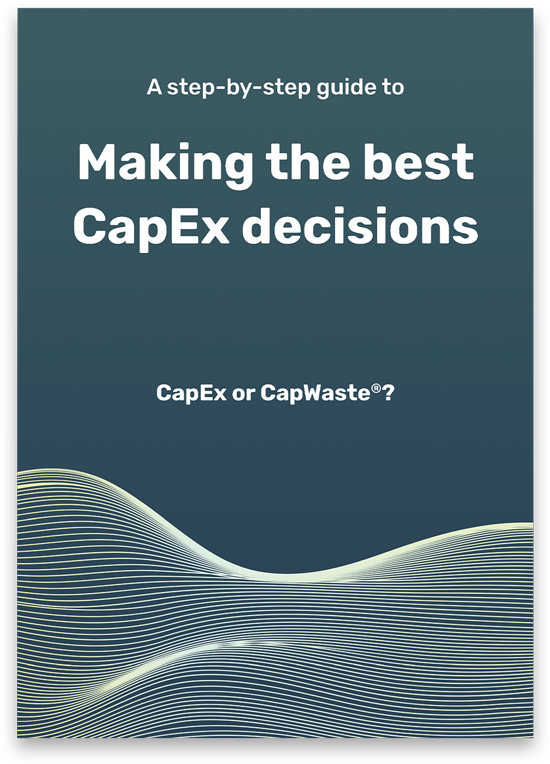
CapEx proposals should be designed to hit a moving, unexpected, unpredictable and unknown target.
That’s a big ask given the CapEx brief was most likely built on some specific assumptions about what the future looks like. Worse, the engineers who design the solution expect the performance constraints to be precisely specified.
There’s no certainty at all in any of the assumptions about how the future will play out, how the economic environment will change, how geo-political forces will reshape your business and the market it’s forced to play in. Whatever you think or planned to happen, probably won’t!
Yet back the wrong assumptions and predictions and the entire basis of making the investment is significantly undermined. It’s not just a direct financial cost of poor ROI, but it often leads to lost opportunity, having to react with your hands tied behind your back, slowing you down and allowing competitors to move into the lead.
Over the next 5 years, $130 trillion is forecast to be invested into the renewal of critical infrastructure globally and decarbonization. That is a 55%-65% increase over the current spend.
Every one of these projects will be forced to respond to changing dynamics, scenarios, constraints, risks that were never foreseen or planned for, putting at substantial risk the performance expectations and ROI on which the decision to invest was made.
Given most CapEx projects have traditionally under delivered by at least 20%, that represents a staggering amount of wasted resources and opportunity.
While that 20% has somehow become “acceptable”, it’s going to get worse. The rate of change is picking up. Companies are expected to move and adapt quicker. There’s more data than ever before. Modelling business scenarios is becoming exponentially more complex. If you aren’t working on developing more strength in this capability, your competitors are, and it could well make or break your success into the future.
Below I want to highlight 3 different scenarios that demonstrate the scale of the problem and why it exists.
First Scenario
Your demand forecasts are almost certainly wrong
Most assets are built in order to meet a specific demand; production targets, passenger numbers, service levels. Future demands are appraised and boiled down into a requirement that the design team can work to.
The problem is that assets are designed to meet that specific requirement; when in reality the demand profile will turn out to be very different. Geo-political events are hard to predict; and their impact is even harder to foresee.
- In 2019 who foresaw the impact of US- China tensions leading to increased demand for micro-chips in the North American market?
- Or in 2018 foresaw the fall in demand for fossil fuels as a result of a global pandemic (and subsequent rise in localised production demand resulting from conflict in Eastern Europe)?
Second Scenario
Your cost projections are almost certainly wrong
Organisations usually build return on investment models based on future cost models , typically arriving at a ‘central’ forecast of future cost escalation (or reduction) – more accurately termed a ‘best guess’. They use these models to evaluate the returns on different discrete design options, arriving at a selected option which gives us the best return on investment (based on our best guess of cost forecast).
But who can confidently predict future costs?
- In 2020 who foresaw that inflation in the UK and US would break out from a 20 year period of 0-4% rates, rising to 10% plus within 2 years?
- In Sep 2020, analysts(1) were forecasting a rise in energy costs from £43/MWh to £107/MWh by end 2021, and advising businesses to budget on £130/MWh for 2022. Yet by mid 2022 costs had risen to £270/Mwh and were forecast to reach £520/Mwh by year end (2)
- In late 2020, who could foresee that global freight container rates would increase five-fold as a result of a blockage of the Suez canal? And then remain elevated for several years when containers were not flowing back to the east due to the pandemic.
Ref :
(1) The alarming future of UK electricity rates: Energy Gain UK, 31 August, 2021
(2) Average Cost of Electricity per kWh in the UK 2022 : Nimblefins, Updated 31 August, 2022 – Erin Yurday, co-founder
Third Scenario
Your asset won’t perform as you expect
In all this uncertainty – surely we can at least be confident in the performance of the asset – after all we’ve had the best design engineers on board? Unfortunately not – most assets fail to achieve their design performance:
- Reliability models are often based on theoretical data, not real world performance. Actual availability of equipment is impacted by environment, operating processes, quality of manufacture, maintenance regimes. So the actual reliability is often very different to the design forecasts.
- Future business challenges result in cutbacks on maintenance, resulting in poor asset condition and frequent failures/downtime. We have seen that most large organisations, when faced with a downturn in financial performance, or as a result of restructuring, cut back on maintenance. This leads to deterioration of the asset condition, resulting increased downtime due to asset failures (or in many cases, complete obsolescence).
- Reliability models don’t take account of humans – making errors, operating equipment out of the design envelope, operating limited shifts. Assets are often damaged by inexperienced personnel, resulting in reduced asset performance.
But on the positive side – a good operations & maintenance team can enhance the performance above design spec through continual improvement. The best organisations grasp the opportunity for reliability growth during the operational lifespan of equipment; monitoring asset condition, tracking and designing-out failure modes as equipment is upgraded.
Why most companies are ill equipped to navigate the issues – and how you can fix it
Few companies are equipped to navigate these issues and ensure that their capital is best deployed whatever the future holds.
Typically, uncertainty is considered at the business level and distilled into a firm spec for the design team. This team then work to give the best solution to a specific requirement. Unfortunately, this gives the best solution to one scenario; one which is almost certainly not going to happen when events get in the way. We will likely find that our finely tuned asset is not best fit for what reality throws at it.
It’s like selecting a thoroughbred flat racing horse for a sprint race, then finding that overnight the course is now water logged, there’s rivers to traverse and fallen trees need to be jumped. What we really needed was a steeplechaser – great in a wider range of conditions.
Fundamentally, we need to become comfortable and proficient at dealing with uncertainty and probability at all levels of the design and optioneering process.
Three things need to happen to give you this capability:
- Engineers have delegated responsibility for dealing with ambiguity, unknowns, and uncertainty back to the business leaders.
Business leaders have delegated technical analysis to the engineers.
It’s a highly ineffective and inefficient process that almost always under bakes the quality of thinking and analysis that needs to be done. We need to find better, more collaborative ways of getting to the result. Dealing with this level of complexity isn’t an engineering or business problem – it’s both and can only be solved together. We need common language, skillsets that straddle both dimensions and processes that break down the silos.
- Methodology of planning CapEx allocation has to change. Just firing shots and hoping they hit the unknown targets that the future will throw up hasn’t worked well in the past. That tolerated 20% CapEx waste metric proves it. But as we prepare for a more rapidly changing and turbulent future, the game may actually be won by those who can deal with uncertainty the best.
- As complexity expands, the options available will grow exponentially with no clarity in how to proceed. Choosing the right option will come down to how well you resolve the complexity back into simple and clear decision making framework.
Few organisations are doing this well.
This isn’t expertise that exists within most organisations. If you need help, this is exactly the problem we can help you solve.









